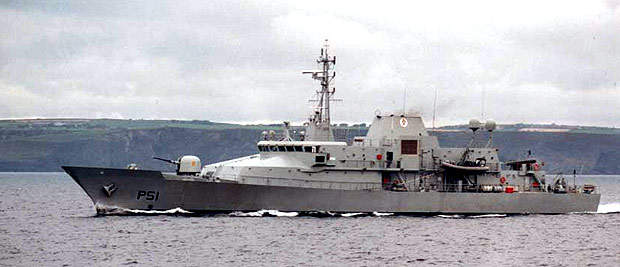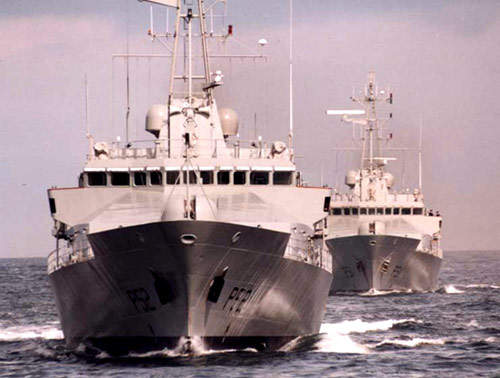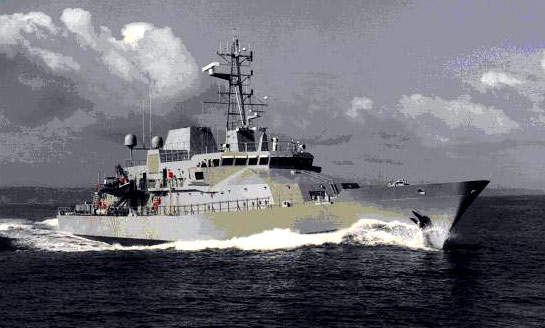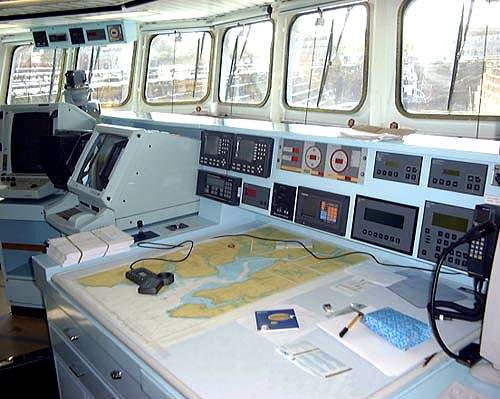The first of class Long Eirennach (Irish Ship) Róisín offshore patrol vessel, pennant number P51, entered service with the Irish Naval Service in September 1999 and the second of class, LE Niamh, P52, entered service in July 2001. Both vessels are based at the Haulbowline Island, Cork Harbour Headquarters and Dockyard.
Appledore Shipbuilders, based in Bideford, North Devon, UK, were selected as prime contractor for the vessels and the contract for the first ship, the Róisín, was placed in December 1997 with an option for a second ship. The contract for the second ship, the LE Niamh was confirmed in April 2000.
DESIGN
The ship has an all-steel hull based on the Mauritian Vigilant patrol vessel launched in 1995, but without the helicopter deck and hangar facilities. The high level of automation incorporated into the ship’s systems allows the ship to be operated with just 47 crew including eight officers. The crew is provided with comfortable accommodation.
The vessel is designed for winter North Atlantic operations and has proved to be exceptionally seaworthy.
WEAPON SYSTEMS
The ship is armed with an OTO Melara 76mm gun installed on the bow gun deck. The gun fires 6kg shells and is capable of firing up to 85 rounds per minute to a range of over 15km. There are also two 12.7mm machine guns.
The main gun is controlled by an Ultra Electronics Command and Control Systems, Radamec 1500 optronic director with a daylight TV camera, thermal imaging camera and eyesafe laser rangefinder. System 1500 functions in automatic or manual mode. The system provides fire control for surface engagement with spotting corrections in both line and range and has an effective secondary self-defence anti-air capability. System 1500 can detect a small patrol boat at ranges in excess of 12km, night or day.
SENSORS
The ship’s Kelvin Hughes surface search radar, operating at E, F and I bands, is installed high on the main mast over the bridge. The Kelvin Hughes navigation radar operates at I-band.
COMMAND AND CONTROL
Marine Electronic Systems (MES) of Southampton, UK, supplied the integrated bridge systems, electronic navigation and communications systems. The communications package includes VHF, HF, Inmarsat Global Maritime Distress Safety System (GMDSS) and Differential Global Positioning System (DFPS) and secure communications
INFLATABLES
Three inflatable boats are deployed from each ship; two 6.5m Delta rigid inflatable boats (RIB) launched with Caley davits, and a single Avon 5.4m RIB.
PROPULSION
The ship is powered by two Wartsila 16V26 diesel engines each developing 5,000kW continuous power. The engines drive two shafts with Lips inboard turning controllable pitch propellers via single reduction gearboxes. Each propeller is 2,500mm in diameter and functions at 300rpm.
The engines provide a maximum speed of 22 knots with a range of 6,000 miles at a cruising speed of 15 knots.
A Brunvoll FU45 CPP bow thrusters, rated at 340kW with 5.6t thrust, is fitted for precision manoeuvring and station keeping. A pair of non-retractable anti-roll fin stabilisers is also fitted.
Three Caterpillar 3412D1-T generators each deliver 405kWe at 1,500rpm. One Caterpillar 3406D1-T emergency generator delivers 205kWe at 1,500rpm.













